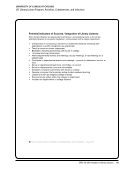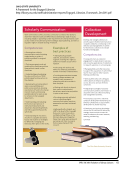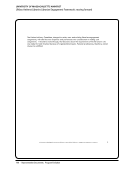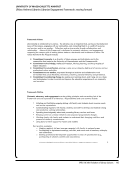48 · Survey Results: Survey Questions and Responses
This really depends on how you define departments. Some liaisons are assigned to schools within the university that
may consist of multiple departments. That would also change the answer to some of the questions above.
Those that express an interest in clinical services support those that actively include clinical services support in
curriculum or research agenda.
Additional Comments N=7
Every department is the goal, but we sometimes discover gaps, new needs, etc., and we assign liaisons whose subject
expertise best matches the need. We do have some departments who have not responded to outreach and therefore
require only minimal contact with a liaison. There is no minimum or maximum number of assigned departments. At this
time, we see little correlation between the size of a department and the workload of the liaison. Assessment is needed
in this area.
Every department on paper, but in practice only some are active departments.
HSL does not assign by departments. We have liaisons for schools (School of Dentistry) and programs/research areas
(bioinformatics, translational science, cancer information).
Some liaisons are assigned a college rather than individual departments. The liaisons assigned an entire college may
work as a team.
Some liaisons serve an entire college such as education, nursing, pharmacy, medicine, dentistry, medicine. Some
colleges have two liaisons such as engineering and business. Other liaisons serve one or a two departments
or programs.
The university has numerous institutes where we may not have an identified liaison, e.g., life sciences institute and data
science institute are two examples.
We have attempted to assign a liaison to every department, however this is now proving unsustainable, and many
departments in medicine no longer have a direct disciplinary liaison. In addition to departments, we have assigned
liaisons to some centres, institutes, and areas of study that fall outside of departmental areas.
17. Which members of the department are eligible for liaison services? Check all that apply. N=66
Teaching/research faculty 66 100%
Other faculty (adjunct, term, non-tenure track, lecturer, etc.) 65 99%
Graduate teaching assistants 63 96%
Graduate students 63 96%
Undergraduate students 62 94%
Administrative staff 58 88%
Other category 15 23%
Please specify the other category. N=15
A health sciences center has different categories. Too many to list here.
All members of the university community are eligible for liaison services.
Alumni, retired faculty
This really depends on how you define departments. Some liaisons are assigned to schools within the university that
may consist of multiple departments. That would also change the answer to some of the questions above.
Those that express an interest in clinical services support those that actively include clinical services support in
curriculum or research agenda.
Additional Comments N=7
Every department is the goal, but we sometimes discover gaps, new needs, etc., and we assign liaisons whose subject
expertise best matches the need. We do have some departments who have not responded to outreach and therefore
require only minimal contact with a liaison. There is no minimum or maximum number of assigned departments. At this
time, we see little correlation between the size of a department and the workload of the liaison. Assessment is needed
in this area.
Every department on paper, but in practice only some are active departments.
HSL does not assign by departments. We have liaisons for schools (School of Dentistry) and programs/research areas
(bioinformatics, translational science, cancer information).
Some liaisons are assigned a college rather than individual departments. The liaisons assigned an entire college may
work as a team.
Some liaisons serve an entire college such as education, nursing, pharmacy, medicine, dentistry, medicine. Some
colleges have two liaisons such as engineering and business. Other liaisons serve one or a two departments
or programs.
The university has numerous institutes where we may not have an identified liaison, e.g., life sciences institute and data
science institute are two examples.
We have attempted to assign a liaison to every department, however this is now proving unsustainable, and many
departments in medicine no longer have a direct disciplinary liaison. In addition to departments, we have assigned
liaisons to some centres, institutes, and areas of study that fall outside of departmental areas.
17. Which members of the department are eligible for liaison services? Check all that apply. N=66
Teaching/research faculty 66 100%
Other faculty (adjunct, term, non-tenure track, lecturer, etc.) 65 99%
Graduate teaching assistants 63 96%
Graduate students 63 96%
Undergraduate students 62 94%
Administrative staff 58 88%
Other category 15 23%
Please specify the other category. N=15
A health sciences center has different categories. Too many to list here.
All members of the university community are eligible for liaison services.
Alumni, retired faculty












































































































































































































